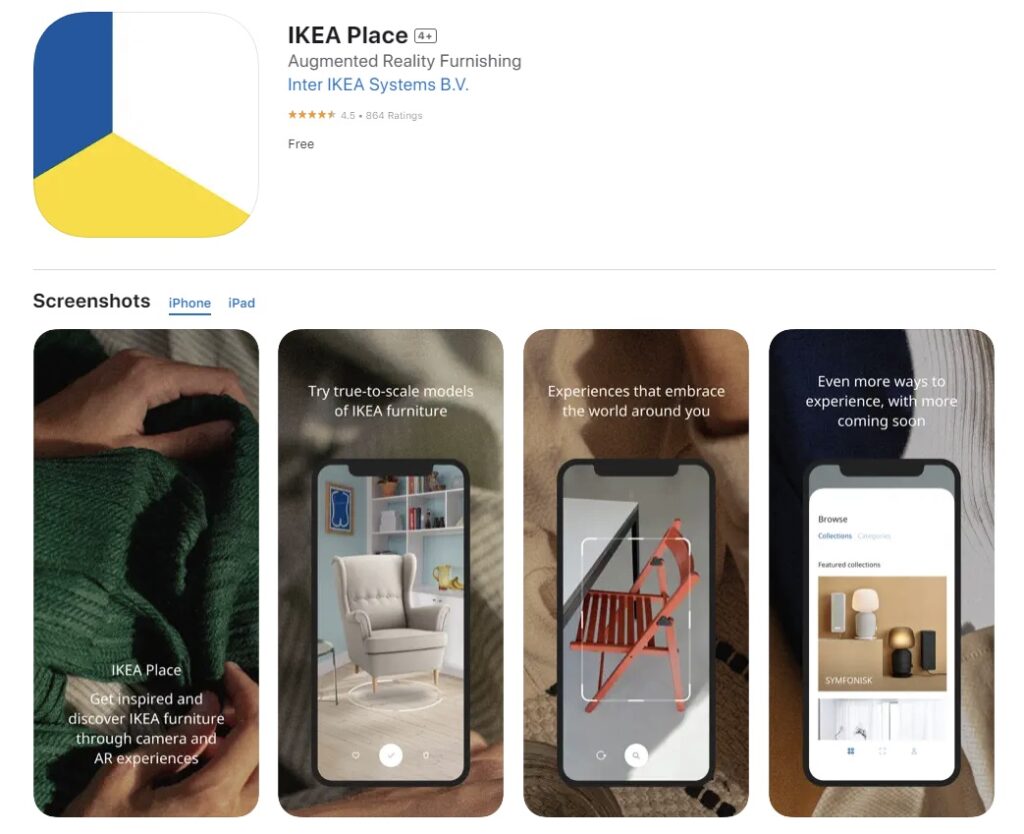Augmented Reality: What eCommerce Owners Should Know
As we move toward a more technologically driven society, AR (augmented reality) is poised to become a mainstream feature in a variety of industries, including eCommerce.
With online shopping continuing to gain popularity, eCommerce stores face the challenge of providing their customers with immersive experiences. Whether it’s trying on clothes, feeling the fabric of a product, or envisioning how furniture will fit in their home, customers want to be able to experience products before making a purchase.
This is where AR technology comes in.
Although it can’t physically place items in homes or try on clothes when shopping online, AR provides customers with the information they need to help make buying decisions with ease and satisfaction. And the necessity is growing. Let’s look at some key stats.
Top Stats for Augmented Reality in eCommerce
- 67% of advertising agencies are utilizing AR to market their products and services
- 40% of online customers are willing to pay a higher price for products if they can preview them through AR technology
- 66% of people are inclined toward using AR for help when shopping
- 93% of Snapchat users are interested in using AR for shopping
In this blog, we’ll delve into the world of augmented reality in eCommerce, discussing top trends, best examples, and best practices to help you make the most of this exciting technology.
These topics include:
Let’s jump in.
What Is Augmented Reality?
Augmented reality, or AR, is an interactive experience generated by the combination of digital visuals, sounds, and other sensory stimuli in real-life environments delivered via holographic technology.
AR offers three unique features:
- Modification of the physical world
- Interactive experiences in real-time
- Accurate 3D depiction of digital and physical objects
Augmented Reality vs. Virtual Reality
Although AR and VR are sometimes used interchangeably, there are many differences between them. They both come under the umbrella term of extended reality (XR).
AR uses the real-world setting and enhances it, while VR is entirely virtual. So, in eCommerce, AR technology overlays the filters and content on the physical environment, while VR takes the shopper or the user to a virtual environment.
AR technology only needs a smartphone to see the enhanced world; on the other hand, VR requires a dedicated headset and safety protocols to experience the virtual world.
And the benefits?
The Benefits of AR in eCommerce
There are three main benefits to integrating AR in your online store:
- Better user experience. AR is highly beneficial for retail, especially for eCommerce industries where potential customers want to actually “try on” their desired product before buying it.
- Improved conversion rates. Since these potential customers will be trying on products virtually, they will surely stay long enough to reduce bounce rates, thus increasing website traffic and improving conversion rates.
- Better customer satisfaction. AR allows customers to get a preview of their desired products before they actually buy them. This helps ensure customers are more likely to be satisfied with their purchases.
AR Shopping Trends to Know in 2023
This year there are five growing AR shopping trends online store brands should be keeping a close eye on. These include:
- Virtual try-on
- Digital showrooms
- Social media apps and camera filters
- AR mirrors
- Expanding AR hardware options
Let’s take a closer look at each.
1. Virtual Try-On
AR empowers brands to offer potential customers an immersive experience via virtual try-on. Virtual try-on is mostly used by brands for product demonstrations, especially in the fashion industry.
Here’s an example from Farfetch, who partnered with Snapchat to introduce virtual try-ons.
Consumers love using AR in shopping. According to Statista, most survey respondents (57% from the silent generation to 92% of Gen Z) were strongly interested in trying new fashion products with AR. This includes makeup, clothing, shoes, and accessories.
2. Digital Showrooms
Digital showrooms, or virtual showrooms, help brands showcase and sell products through a user-friendly online platform. They can include features such as 360-degree product views, videos, and interactive product tours that can enhance the overall shopping experience.
A great example of a digital showroom is Hyundai’s Evolve showroom on Amazon.
[Source: Amazon]
Customers who browse this digital showroom have the opportunity to explore the cars that are available at participating dealerships. They can also customize their preferred Hyundai vehicle, get an estimated price, monitor inventory in real-time, and get in touch with dealerships to finalize the purchase.
Digital showrooms simplify the ordering process and enable buyers to make informed decisions based on accurate and up-to-date information.
3. Social Media Apps and Camera Filters
The pandemic has made customers more inclined to spend more time online. That leads brands to strategically engage and entice them toward using their eCommerce channels.
According to Deloitte, this trend and strategy will prevail as 75% of the global population, and nearly all smartphone users, will adopt AR technology. And the majority are already discovering AR through social media apps such as Snapchat and Instagram.
4. AR Mirrors
AR mirrors are one of the biggest eCommerce trends, which are already catching the attention of consumers. There are two ways AR mirrors work:
- The first way is having a mirror backed up by a digital screen with dynamic motion-sensor technology and then using AR to overlay images onto the mirror in real-time.
- The second way doesn’t involve any mirror, but it’s like a giant smartphone camera; a digital camera overlays AR filters.
This trend has tons of potential in the coming years. As a matter of fact, Snapchat reports that 21% of customers would definitely go to a store with a smart mirror, while 33% of them would use it to try on clothes and other accessories.
Here’s an example of an AR mirror in action from augmented reality experts INDE.
5. Expanding AR Hardware Options
Every year there are powerful innovations in mobile phone technology to complement the latest AR features. Those features include depth-sensing hardware such as LiDAR (light detection and ranging) and ToF (time of flight).
The projected AR market revenue growth numbers reflect those changes in mobile technology. According to Statista, they are estimated to be $12.45 billion in 2021, which will increase to $36 billion by 2026.
However, the smartphone isn’t the only technology equipped with AR. As this technology becomes more ubiquitous, tech giants such as Google, TCL, Microsoft, and many others are investing in building smart glasses. Some were even announced at last year’s CES (Consumer Electronics Show).
Successful Examples of eCommerce Retailers Using AR
Now, let’s look at some retailers already staying ahead of the competition with AR.
1. IKEA
IKEA, the Swedish furniture retailer, is undoubtedly one of the most successful examples of AR implementation in eCommerce. They developed an AR app, “IKEA Place,” for customers to visually experience how furniture and home decor items will look in their homes before making a purchase.
[Source: IKEA Place Apple Store]
Customers just need to scan their living space and then place virtual IKEA furniture in the “room.” They can even adjust the size and placement of items for a more accurate idea of how they would look in place — saving them the hassle of having to move furniture around or physically taking measurements.
IKEA’s use of AR technology in eCommerce has been a major success, providing customers with a more engaging and personalized shopping experience while increasing sales and reducing returns.
2. Sephora
Well-known beauty brand Sephora is another excellent example of the success of augmented reality in eCommerce. Sephora launched its “Virtual Artist” app, allowing customers to try different makeup products virtually.
The Sephora app allows its customers to upload a photo of themselves or use their smartphone camera to see how different makeup products would look on their faces. For a more realistic look, the app uses facial recognition features. Customers can try different varieties of makeup, lipsticks, foundations, etc., to choose the perfect shade.
Additionally, Sephora has gone a step further by bringing AR technology to its physical stores. They introduced in-store magic mirrors for customers to virtually try on makeup in real-time. This use of AR technology helps them increase sales and provide an engaging shopping experience for their customers.
3. ASOS
ASOS, an online fashion retailer, developed an AR app called “Virtual Catwalk,” which allows their customers to preview clothes on a virtual model. They can choose from a variety of poses to see how the clothes move and fit on the virtual model. The model can be rotated and viewed from different angles.
This app helped the ASOS brand stand out from the competition, delivering a personalized shopping experience.
4. Amazon Salon
Amazon’s Salon is yet another example of AR success in the eCommerce industry. It offers virtual hair coloring with AR, locating the customer’s hair using facial recognition technology.
With Amazon Salon, customers just need to upload their photos or use their smartphone camera to view how the color looks on them before experimenting with their hair in real life.
How to Leverage Augmented Reality for Your Online Store
Before implementing augmented reality for eCommerce, you want to ensure you:
- Set clear goals
- Identify the type of AR technology
- Understand your audience
- Track and measure customer engagement
Let’s quickly review each in more detail.
1. Set Clear Goals
Do you want to increase sales, drive more traffic to your website, or increase your website ranking on SERP? Once you get the answers to these questions, you’ll be in a better position to achieve your desired goals and long-term objectives.
2. Identify the Type of AR Technology
There are different types of AR technology. For example, marker-based AR allows your customers to virtually try on products before buying them. Projection-based AR allows your customers to project the products into their homes to see whether the product looks good and fits well in their space.
3. Understand Your Audience
When it comes to the use of augmented reality in eCommerce marketing, getting to know your customers in detail is beneficial. It allows you to resonate with your target audience and reach them in the best possible way. For example, you need to identify whether they’re early adopters of the product or service or whether they need a little convincing.
4. Track and Measure Customer Engagement
In order to maximize the benefits of AR in eCommerce, it is crucial to track customer engagement and measure how well your AR content is resonating with your audience. There are several customer engagement tools available that can help you track user behavior and interactions with your AR content. These tools can give you valuable insights into how your customers are engaging with your AR experiences and what kind of products they find most interesting.
Final Thoughts
Augmented reality technology has the potential to revolutionize the eCommerce industry by enhancing the customer experience and improving business outcomes. It’s also one of the great eCommerce growth strategies to look forward to in 2023.
As demonstrated in this quick guide, AR can be utilized in various ways, such as virtual try-ons, product visualization, and immersive shopping experiences.
And as technology continues to evolve and become more accessible, it is likely that more businesses will integrate AR into their eCommerce strategies to stay competitive and meet the expectations of modern consumers.
Therefore, it’s time for eCommerce businesses to explore AR possibilities and use it as a tool to delight customers and increase conversions.


Mary Paulene Omae
Mary Paulene is a Senior Content Editor for RingCentral, a leading provider of global enterprise cloud communications, video meetings, collaboration, and contact center solutions. She has a Bachelor’s degree in Journalism and a great passion for learning foreign languages. Connect with her on LinkedIn.
Comments
comments
Powered by Facebook Comments







